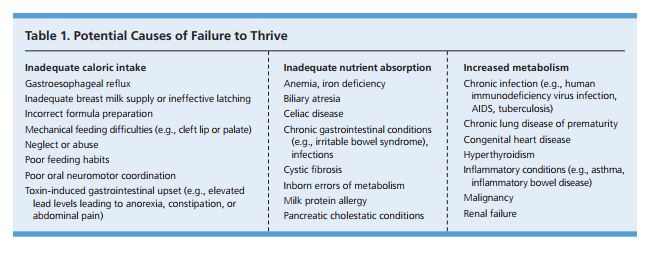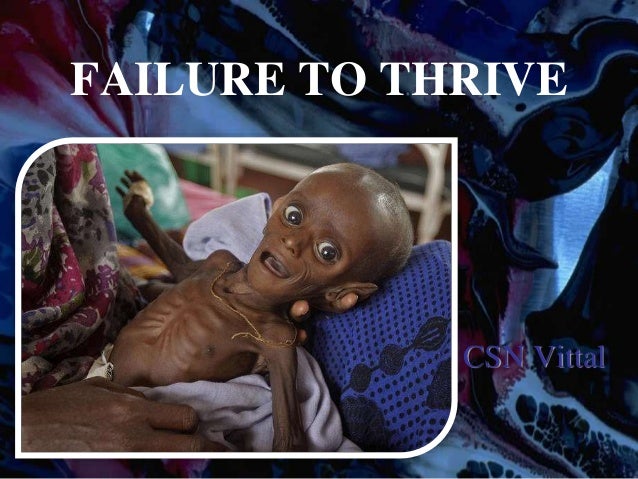
Multiple definitions exist and are considered valid: Gender Dysphoria, or a drop in weight that crosses 2 major percentile lines on standardized growth charts in a 6-month period. Failure to thrive is measured as a drop below the 5th percentile for age and sex Sex The totality of characteristics of reproductive structure, functions, phenotype, and genotype, differentiating the male from the female organism.
Failure to thrive meaning infants pro#
Students: Educators’ Pro Tips for Tough Topicsįailure to thrive (FTT) describes suboptimal weight gain and growth in children.Fundamentals of Nursing: Clinical Skills.An important message from this study is that the authors attribute the absence of a systematic effect of social variables on poor weight gain in infants to the ready availability of social security aid in UK which reduces the level of poverty and increases food availability in families with small children. Although there was no significant association between poor weight gain and parental occupation or socio-economic class there was an association with living in rented accommodation or not having the use of a car or telephone. The risk of poor weight gain was also shown to be increased in subsequent siblings. Significant associations between slow weight gain and both maternal and paternal height and high parity were identified. Slow weight gain was identified in 531/11 187 (4.5%) of infants in whom complete data was available at 9 months. This data was then compared with demographic data (obstetric history, parental anthropometry, and socio-economic status etc.) obtained by questionnaire. Having excluded premature infants and those with congenital abnormalities growth data was available on 11 718 infants who were measured at birth, 6–8 weeks, and 9 months. Cases of FTT were identified (with an elegant handling of the data which takes into account regression to the mean) as those whose weight gain was a below a z-score of −1.645. 2ĪLSPAC is a cohort study of child growth and development based on pregnant mothers who were recruited in the South West of England between 19. A study from an urban area of the UK which identified children with FTT using the thrive index (defined as the ratio between the predicted weight gain and actual weight gain) showed (1) that the majority were not from the most deprived areas of the city, (2) that overt neglect was rare, and (3) that 76% were living in apparently caring homes but were nevertheless undernourished. It can be very difficult during this period of reduced growth velocity to be confident that such a child is not failing to thrive.) Consequently, those children from more affluent backgrounds may be being missed and/or present later than they should. These children usually present with a severe deceleration in growth in the first 2 years of life with a subsequent realignment to a centile line and normal growth increments until adolescence when a growth spurt occurs. However, similar children from a higher socio-economic class are more likely to be described as ‘constitutional short stature’ (this is generally considered a normal variation of growth. In particular, it has been noted that because of this assumption that deprivation is a risk factor, children with a weight less than the third centile who are from a low socio-economic class are more likely to be labelled as FTT (and hence referred).

Recent studies suggest, in fact, that the majority of children with FTT come from the larger population of more ‘average’ income backgrounds.

The report from the Avon Longitudinal Study of Parents and Children (ALSPAC) 1 in this issue of the International Journal of Epidemiology is, therefore, a welcome addition to the FTT literature as it also fails to demonstrate a systematic effect of social variables on poor weight gain in infants. There is, in fact, little objective evidence to support this putative link with poverty.

As a consequence of this, most studies of FTT have focused on highly deprived groups and produced skewed and unhelpful results. Some of the difficulties in interpretation of findings are related to a preconception by health workers and researchers that FTT is always linked with poverty. The imprecision of this data is a reflection of the difficulties in assessing the frequency of the occurrence of FTT in children. The population prevalence of FTT has been found to range anywhere between 1.3% and 20.9% depending on the definition of FTT that is used. This will be an underestimate of its true incidence, however, as FTT is identified and treated primarily in the community. FTT accounts for 1–5% of paediatric hospital admissions under 2 year of age. Although failure to thrive (FTT) is a common problem, precise epidemiological data is lacking.


 0 kommentar(er)
0 kommentar(er)
